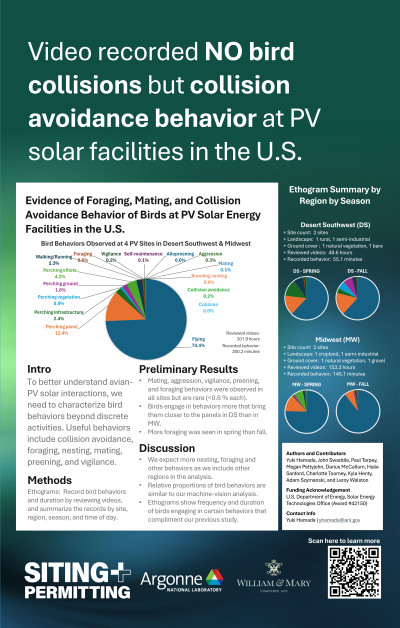Evidence of Foraging, Mating, and Collision Avoidance Behavior of Birds at PV Solar Energy Facilities in the U.S.
Tuesday, April 15, 2025
5:00 PM - 6:00 PM PT
Location: Regency Ballroom


Yuki Hamada, PhD
Biophysical Remote Sensing Scientist
Argonne National Laboratory
Lemont, Illinois
Poster Presenter(s)
How birds interact with large-scale photovoltaic (PV) solar energy facilities in the United States remains unclear. Some studies suggest that proper siting and management of PV facilities could provide suitable sites for foraging and nesting, benefiting bird populations. Previously, we extracted discrete bird activities around PV solar facilities from continuous daytime video recordings. Since then, we have progressed to quantitatively characterizing bird behaviors via ethogram analysis of those daytime videos collected from the southwest and Midwest regions of the U.S. Bird behaviors being characterized include foraging, mating, preening, vigilance, aggression, and collision avoidance. Birds observed were in flight nearly 75% of the time. They engage more in perching and foraging that bring them closer to the panels at solar facilities in the Southwest (37%) than in the Midwest (21%). Although rare ( <1%), we observed foraging, vigilance, preening, aggression, and mating behaviors at all sites. We observed more foraging in spring (55-61%) than fall (36-40%) in both regions. We observed no collisions but did observe collision avoidance behavior (~0.3%) in both regions and both seasons. Overall collision avoidance behavior was more frequent in the Midwest than in the Southwest. In the Midwest, birds exhibited more collision avoidance behaviors in spring than fall while they showed such behaviors more frequently in fall than in spring in the Southwest. Although preliminary, our findings provided new insights for current understanding of avian-solar interactions.
